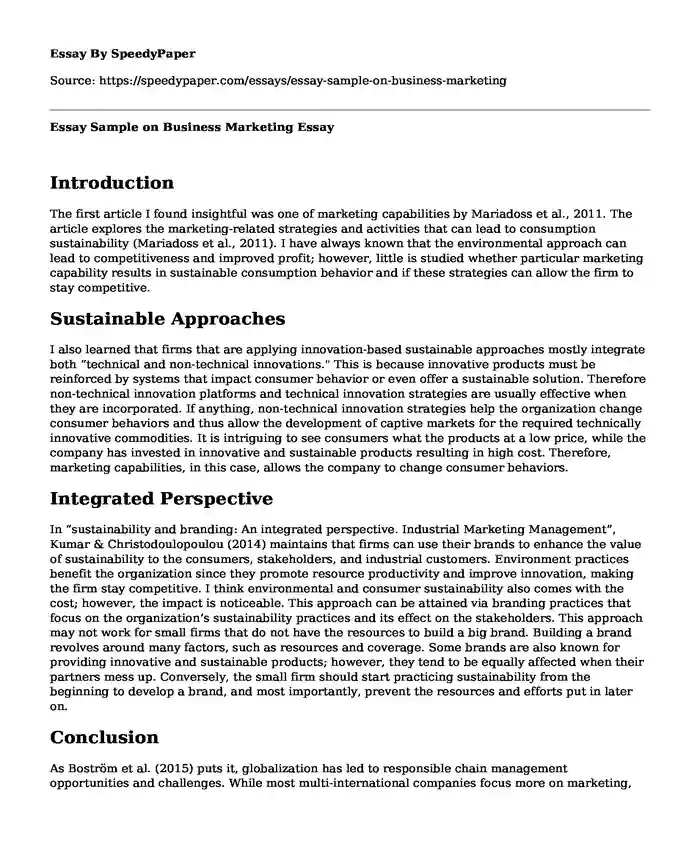
| Type of paper: | Essay |
| Categories: | Marketing Business Sustainable development |
| Pages: | 3 |
| Wordcount: | 642 words |
Introduction
The first article I found insightful was one of marketing capabilities by Mariadoss et al., 2011. The article explores the marketing-related strategies and activities that can lead to consumption sustainability (Mariadoss et al., 2011). I have always known that the environmental approach can lead to competitiveness and improved profit; however, little is studied whether particular marketing capability results in sustainable consumption behavior and if these strategies can allow the firm to stay competitive.
Sustainable Approaches
I also learned that firms that are applying innovation-based sustainable approaches mostly integrate both “technical and non-technical innovations." This is because innovative products must be reinforced by systems that impact consumer behavior or even offer a sustainable solution. Therefore non-technical innovation platforms and technical innovation strategies are usually effective when they are incorporated. If anything, non-technical innovation strategies help the organization change consumer behaviors and thus allow the development of captive markets for the required technically innovative commodities. It is intriguing to see consumers what the products at a low price, while the company has invested in innovative and sustainable products resulting in high cost. Therefore, marketing capabilities, in this case, allows the company to change consumer behaviors.
Integrated Perspective
In “sustainability and branding: An integrated perspective. Industrial Marketing Management”, Kumar & Christodoulopoulou (2014) maintains that firms can use their brands to enhance the value of sustainability to the consumers, stakeholders, and industrial customers. Environment practices benefit the organization since they promote resource productivity and improve innovation, making the firm stay competitive. I think environmental and consumer sustainability also comes with the cost; however, the impact is noticeable. This approach can be attained via branding practices that focus on the organization’s sustainability practices and its effect on the stakeholders. This approach may not work for small firms that do not have the resources to build a big brand. Building a brand revolves around many factors, such as resources and coverage. Some brands are also known for providing innovative and sustainable products; however, they tend to be equally affected when their partners mess up. Conversely, the small firm should start practicing sustainability from the beginning to develop a brand, and most importantly, prevent the resources and efforts put in later on.
Conclusion
As Boström et al. (2015) puts it, globalization has led to responsible chain management opportunities and challenges. While most multi-international companies focus more on marketing, brand management, and product design, the low skill manufacturing activities are always outsourced to the nations with low income. The geographical gap is a problem since the consumers and manufacturers are far apart. No one questions product sustainability and the context in which it was developed (LeBaron, Lister, & Dauvergne, 2017). The product might be a result of severe environmental degradation, but who knows. Thus, these sources are resourceful in my future career. As a professional business person, I will always do what is right, whether I am being monitored or not. More so, transparency is essential; people need to know what they are taking in and its effect.
References
Boström, M., Jönsson, A. M., Lockie, S., Mol, A. P., & Oosterveer, P. (2015). Sustainable and responsible supply chain governance: Challenges and opportunities. Journal of Cleaner Production, 107, 1-7. https://www.academia.edu/28704278/Sustainable_and_responsible_supply_chain_governance_challenges_and_opportunities
Kumar, V., & Christodoulopoulou, A. (2014). Sustainability and branding: An integrated perspective. Industrial Marketing Management, 43(1), 6-15.
http://www.pmir.it/fileCaricati/0/Kumar%20e%20Christodoupoulou%20(2014).pdf
Mariadoss, B. J., Tansuhaj, P. S., & Mouri, N. (2011). Marketing capabilities and innovation-based strategies for environmental sustainability: An exploratory investigation of B2B firms. Industrial Marketing Management, 40(8), 1305-1318.
https://isiarticles.com/bundles/Article/pre/pdf/26639.pdf
LeBaron, G., Lister, J., & Dauvergne, P. (2017). Governing global supply chain sustainability through the ethical audit regime. Globalizations, 14(6), 958-975.
https://www.tandfonline.com/doi/full/10.1080/14747731.2017.1304008.
Cite this page
Essay Sample on Business Marketing. (2023, Dec 25). Retrieved from https://speedypaper.net/essays/essay-sample-on-business-marketing
Request Removal
If you are the original author of this essay and no longer wish to have it published on the SpeedyPaper website, please click below to request its removal:
- Free Essay on EasyJet and Ryanair Profitability
- Free Essay Example: Budgeting
- Paper Sample: Problems Confronted By the Freight Project
- Free Essay. Types of Employees That Should Be Empowered in an Organization
- Essay Sample on The Foreign Exchange Markets
- International Strategy Issues - Free Essay Sample
- Understanding Factors in Young Children's Development - Free Essay Sample
Popular categories




